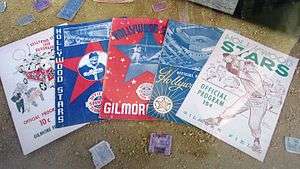Gilmore Field
| Location | Beverly Boulevard Hollywood, California, United States |
|---|---|
| Capacity | 12,987 |
| Field size |
Left Field – 335 ft. Center Left – 385 Center Field – 400 ft. Center Right – 385 Right Field −335 ft. |
| Surface | Grass |
| Construction | |
| Broke ground | 1938 |
| Opened | May 2, 1939 |
| Closed | September 5, 1957 |
| Demolished | 1958 |
| Tenants | |
|
MLB Spring Training: Pittsburgh Pirates (NL) (1948) Minor League Baseball: Hollywood Stars (PCL) (1939–1957) | |
Gilmore Field was a former minor league baseball park in Los Angeles, California, that served as home to the Hollywood Stars of the Pacific Coast League from 1939–57 when they, along with their intra-city rivals, the Los Angeles Angels, were displaced by the transplanted Brooklyn Dodgers of the National League.
History
Gilmore Field opened on May 2, 1939 and was the home of the Hollywood Stars of the Pacific Coast League until September 5, 1957. The stadium had a seating capacity of 12,987 people.
Location
The ballpark was located on the south side of Beverly Boulevard between Genesee Avenue and The Grove Drive, just east of where CBS Television City is currently located. A couple hundred meters to the west was Gilmore Stadium, an oval-shaped venue built several years earlier, which was used for football games and midget auto racing. To the east was the famous Pan-Pacific Auditorium. Both facilities were built by Earl Gilmore, son of Arthur F. Gilmore and president of A. F. Gilmore Oil, a California-based petroleum company which was developed after Arthur struck oil on the family property.[1] The area was rich in petroleum, which was the source of the "tar" in the nearby La Brea Tar Pits.
Field
The field had intimate quarters from the spectator standpoint – first and third bases were 7.2 meters (24 feet) from the first row of seats. Home plate was 10.2 meters (34 feet) from the stands.[2] The outfield gave the pitchers more of a break with foul lines 101 meters (335 feet) long, power alleys about 116 meters (385 feet), and 123 meters (407 feet) to center field. (Ritter, p. 75) The power alleys were thus 12 meters (40 feet) deeper than in the cross-town counterpart, Wrigley Field.
Hollywood Stars

In 1938 Herbert Fleishaker, owner of the Mission Reds moved his team to Los Angeles, and took the name of the Hollywood Stars after the city's previous PCL franchise. After but one season, the team was sold to new owners, among them Bob Cobb of Brown Derby Restaurant fame and the inventor of the California Cobb Salad. In their salad days, as it were, the Stars attracted glamorous actors and other celebrities or anyone else who wanted to be "seen", much as Dodger Stadium would later. One of the L.A. Angels players, Chuck Connors, made a successful move from one side of the box seat railing to the other, becoming the star in "The Rifleman", a popular 1950's TV show. The Stars would play at Gilmore Field until 1957.
Pittsburgh Pirates
In 1948, Gilmore Field became the spring training location for the Pittsburgh Pirates.
Movies
Although L.A.'s Wrigley Field seemed to get the lion's share of Hollywood screen time, Gilmore Field also had its moments on celluloid. It was featured in a 1949 movie called The Stratton Story, starring James Stewart and June Allyson, the true story of a promising pitcher (Monty Stratton) whose career was curtailed due to a hunting accident that left him with an artificial leg. Stratton's major league baseball career was over, but he made a comeback at the minor league level. The scenes at the end of the movie were set elsewhere, but were filmed at Gilmore Field. The layout of the outfield, and especially the exceptionally high left and right field corners, help to identify it.
Gilmore Field was also seen in 711 Ocean Drive (1950).
Demolished
The ballpark site was abandoned after 1957. Gilmore Field was razed in 1958, and much of the site is now occupied by a parking lot at CBS Television City, near the Farmers Market. In September 1997, the Pacific Coast League Historical Society, CBS, and the A.F. Gilmore Company dedicated a bronze plaque in commemoration of Gilmore Field on a wall outside CBS Studio 46. "The Ferris Wheel", one of the episodes of "Rescue 8", a syndicated United States television series broadcast in September 1958, was filmed at the demolition of Gilmore Field and includes many views of the stadium as it was being razed.
References
- ↑ "Gilmore Field". Project Ballpark. Retrieved January 11, 2014.
- ↑ The Sporting Life (Farmer's Market), Retrieved June 22, 2007
- "Lost Ballparks" by Lawrence Ritter.
External links
- Colorized postcard of Gilmore Stadium, Gilmore Field, Pan Pacific Auditorium and Farmers Market
- Gilmore Field Model
Coordinates: 34°4′31″N 118°21′36″W / 34.07528°N 118.36000°W